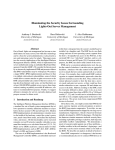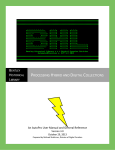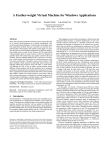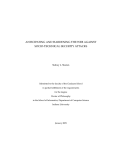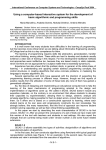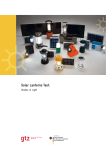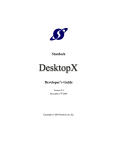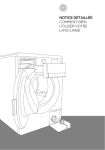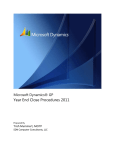Download Applications of a Feather-weight Virtual Machine - ECSL
Transcript
Applications of a Feather-weight Virtual Machine
Yang Yu
Hariharan Kolam govindarajan
Lap-Chung Lam
Tzi-cker Chiueh
Computer Science Department, Stony Brook University
{yyu, kghari, lclam, chiueh}@cs.sunysb.edu
Abstract
A Feather-weight Virtual Machine (FVM) is an OS-level virtualization technology that enables multiple isolated execution environments to exist on a single Windows kernel. The key design goal
of FVM is efficient resource sharing among VMs so as to minimize VM startup/shutdown cost and scale to a larger number of
concurrent VM instances. As a result, FVM provides an effective
platform for fault-tolerant and intrusion-tolerant applications that
require frequent invocation and termination of dispensable VMs.
This paper presents three complete applications of the FVM technology: scalable web site testing; shared binary service for application deployment and distributed Display-Only File Server (DOFS).
To identify malicious web sites that exploit browser vulnerabilities,
we use a web crawler to access untrusted sites, render their pages in
multiple browsers each running in a separate VM, and monitor their
execution behaviors. To allow Windows-based end user machines
to share binaries that are stored, managed and patched on a central
location, we run shared binaries in a special VM on the end user
machine whose runtime environment is imported from the central
binary server. To protect confidential files in a file server against information theft by insiders, we ensure that file viewing/editing programs run in a VM, which grants file content display but prevents
file content from being saved on the host machine. In this paper, we
show how to customize the generic FVM framework to accommodate the needs of the three applications, and present experimental
results that demonstrate their performance and effectiveness.
Categories and Subject Descriptors D.4.6 [Operating Systems]:
Security and Protection; K.6.3 [Management of Computing and
Information Systems]: Software Management
General Terms
Security, Management
Keywords virtual machine, web crawler, browser exploit, binary
server, information theft
1. Introduction
Virtual machine is a software abstraction that provides multiple execution environments on a single physical machine. A virtualization layer can be placed at different levels along the machine stack.
Hardware-level virtual machines emulate the hardware and allow
each VM to have its own operating system. In contrast, OS-level
Permission to make digital or hard copies of all or part of this work for personal or
classroom use is granted without fee provided that copies are not made or distributed
for profit or commercial advantage and that copies bear this notice and the full citation
on the first page. To copy otherwise, to republish, to post on servers or to redistribute
to lists, requires prior specific permission and/or a fee.
VEE’08, March 5–7, 2008, Seattle, Washington, USA.
c 2008 ACM 978-1-59593-796-4/08/03. . . $5.00
Copyright virtual machines partition the OS kernel and allow each VM to run
a set of applications isolated from other VMs.
Feather-weight Virtual Machine (FVM) is an OS-level virtualization technology for Windows machines. It is designed to efficiently share resources of a physical machine among VMs running
on top of it. FVM intercepts accesses to system resources from
processes running inside a VM, and renames the target resources
so that one VM cannot name resources owned by another VM, let
alone compromise them. To enforce state isolation, when a VM
attempts to modify certain resource, FVM makes a copy of that resource in the VM’s private workspace through copy-on-write. Each
VM in FVM has minimal physical resource requirement because it
shares most of its resources with the base host environment. This
design greatly reduces the VM’s startup/shutdown time and is more
scalable in terms of the number of concurrent VMs that can be supported on a physical machine. As a result, FVM provides an excellent platform for fault-tolerant and intrusion-tolerant applications
that require frequent invocation and termination of “dispensable”
VMs.
We have developed the FVM prototype on Windows 2000/XP
and applied it to protect an end user machine from malicious mobile code by running web browsers, email clients and downloaded
programs in a VM [1]. Another application of the FVM framework
is an automated and safe vulnerability assessment system called
VASE [2], which allows vulnerability scanning to run in a highfidelity and safe manner by cloning production-mode network applications into a VM and running vulnerability scanners against this
VM. In this paper, we present three new applications of FVM: scalable web site testing, shared binary service for application deployment, and distributed Display-Only File Server.
In a web site testing system, which proactively scans untrusted
web sites to determine if they contain malicious content, we need
a virtual machine technology to isolate potential malignant side effects of browser attacks of malicious web sites from the physical
machine. FVM’s small VM startup and shutdown overhead is a perfect match for this application and has been shown to significantly
improve the throughput of a web site testing system.
In the shared binary service architecture, which requires an end
user machine to fetch all its application binaries from a central
server, we need to provide applications that are installed on a shared
binary server but executed on a client machine. The application’s
execution environment, including registry settings, configuration
files, DLLs and COM objects, also comes from the binary server.
FVM’s OS-level virtualization technique can be easily tailored to
this application, and makes it possible to reap the performance
benefit of client-server computing and the centralized management
benefit of thin-client computing.
Display-Only File Server (DOFS) [3] is an information protection technology that guarantees bits of confidential documents
never leave the protected file server after being checked in. Because DOFS is based on the thin-client computing architecture, it
has both application compatibility and scalability problems. Dis-
tributed DOFS, which attempts to extend the control of a central
DOFS server to individual clients, leverages FVM to run a special
VM in each client machine that is considered as a logical extension
of the central DOFS server. As a result, distributed DOFS eliminates the compatibility/scalability problems of centralized DOFS
while retaining its effectiveness in protecting confidential documents from information theft.
2. Related Work
Virtual Machine Technology Virtual machine technology has
been implemented at multiple levels of abstraction. Hardware-level
virtual machines emulate the entire instruction set architecture [4]
or the hardware abstraction layer [5, 6] to run guest operating systems with zero or small modifications. In contrast, OS-level virtual
machines [7, 8, 9, 10] partition system resources on a single OS
kernel so as to support multiple execution environments that are
isolated from one another. Because these isolated execution environments are designed to share as much system resources as
possible, OS-level VMs typically have smaller startup/shutdown
overhead and larger scalability.
Web Site Testing The Strider HoneyMonkey [11] is a large-scale
web site testing system to identify malicious web sites that exploit
browser vulnerabilities. It consists of a pipeline of “monkey programs” running Internet Explorer browsers in virtual machines.
From a given URL list, it drives browsers to visit each URL and
detects browser exploits by monitoring unexpected state changes.
Upon detection of an exploit, the system destroys the infected VM
and restarts a clean VM to continue the test. A crawler-based study
on spyware [12] uses a similar testing framework to detect spywareinfected executables on the web. In addition, the study also analyzes
drive-by downloads that mount browser exploit attacks, and tests
them with Internet Explorer and Firefox. A group in Google performed another analysis to web-based malware [13] using a similar approach. The SpyProxy [14] intercepts HTTP requests with
an HTTP proxy, fetches the target web pages into a local cache,
and checks the safety of the pages before passing them to the client
browser for rendering. The malware detection procedure consists
of both a static analysis to the web content and a dynamic analysis
inside a VM.
All of these web site testing systems use hardware-level virtual
machines to host web browsers. In contrast, we have developed a
web site testing system based on FVM, an OS-level virtual machine
technology. We will demonstrate that our system is more scalable
and is a better fit for real-time browser exploit detection.
Application Deployment Architecture Modern enterprises have
the following application deployment architectures to manage application binaries on end user machines: local installation, thin
client computing, OS steaming, network boot, application streaming and shared binary service. In the local installation architecture,
application binaries are installed and executed on end user machines, and a network-wide application installation/patching tool
is needed to reduce the application management cost. In the thin
client computing architecture, such as Microsoft’s Windows Terminal Service [15], application binaries are installed on a central
server and executed on the server CPU. An end user machine displays the result of application executions and replays user inputs via
a special protocol such as Remote Desktop Protocol (RDP). Due to
centralized binary installation and execution, this architecture lowers the overall application maintenance cost, but also incurs larger
application runtime latency and higher network traffic load.
Network boot allows a diskless end user machine to boot from a
kernel image stored on a remote server, and then run the OS and application code on the machine’s local CPU. Citrix’s Ardence [16]
supports network boot by implementing a remote virtual disk system. An end user machine boots from the network through Preboot
eXecution Environment (PXE) and then accesses the virtual disk
via a protocol called BXP. However, because of hardware dependencies, the virtual disk of each end user machine may be different
from one another and thus require extensive customization. A similar architecture is OS steaming [17, 18], which configures an OS
and a specific set of applications into a hardware-level virtual machine image stored on a central server. An end user machine runs
one of these VM images on a Virtual Machine Monitor (VMM).
Because a VM image is isolated by the VMM from the underlying
physical hardware, in theory it has less hardware dependencies. In
practice, the hardware dependencies are transferred to the VMM,
which is not necessarily the best party to deal with hardware dependencies because of its emphasis on minimal code base.
In the application streaming architecture [19, 20, 21, 22], application binaries and configurations are bundled into self-contained
packages, which are stored and maintained centrally. An end user
machine running a compatible OS fetches these packages from the
server and runs them directly without local installations. Each such
package runs in a virtual environment, and is cached on the local
machine whenever possible. This architecture offers the advantages
of both centralized application management and localized application execution on end user machines.
The shared binary service architecture, which is widely used
in the UNIX world, is similar to application streaming except that
it does not require explicit application packaging, and it allows
resource sharing among packages. More concretely, applications
are installed on a shared binary server, and then exported to all end
user machines through a standard network file sharing interface.
When an application is executed, accesses to binaries, configuration
files, registry settings are redirected to the central binary server.
Information Theft Prevention Existing solutions to the information theft problem are based on access control and content filtering.
Standard access control from the OS is not sufficient because they
cannot prevent information theft by authorized users who have legitimate access to the stolen information. Content filtering monitors data transferred across an enterprise’s network boundary to detect possible confidential information leakage. However, this technology is weak with respect to encrypted packets and is therefore
mainly for accidental leakage rather than malicious theft.
Digital Rights Management (DRM) [23, 24, 25] protects an
enterprise’s intellectual property by encrypting a protected document and associating fine-grained access rights with the document.
Typical rights include whether modifications are allowed, when
the rights expire, how the rights are transferred, etc. DRM systems tightly integrate encrypted documents with their access rights.
When a DRMed document is accessed, the DRM client software
decrypts the document, interprets the access rights, and authorizes
proper document usage according to the specified rights. Because
of this tight integration, DRM software needs to be implemented as
a plug-in for standard document viewing/editing programs, such as
Microsoft Office and AutoCAD, and therefore requires expensive
customization.
3. FVM Architecture
FVM is designed to facilitate resource sharing among VMs in order
to minimize the virtualization overhead and scale to a large number
of concurrent VMs, while providing strong isolation between VMs.
FVM virtualizes system resources at the OS system call interface,
as shown in Figure 1. It virtualizes access requests to system resources such as files and registries by name re-mapping and copyon-write. Much like virtual memory protection, processes running
in one VM cannot interfere with those in another VM because they
User
VM_1
VM_2
Processes
Processes
"a\b"
"a\b"
Kernel
System Call
Interception
File, Registry, Object, IPC, Device, Network, Window, Daemon
Virtual to Physical Mapping
(share-on-read, copy-on-write)
FVM virtualization layer
"vm_1\a\b"
"vm_2\a\b"
Windows Kernel (NT, Win32K)
Figure 1. FVM supports isolated VM instances on a single OS
kernel by re-mapping access to system resources at the OS system
call interface.
cannot even name system resources owned by other VMs. In the
FVM architecture, all VMs share the same kernel image, and start
with exactly the same execution environment as the underlying host
machine. Consequently, the startup cost of a new VM is minimal.
Because FVM implements state isolation by copy-on-write, each
VM only requires a small amount of system resources. As a result, FVM can easily support a larger number of concurrent VM
instances than HAL-based virtualization technologies.
FVM intercepts each access to system resources by processes
running in a VM at the system call interface and decides whether
to pass through, redirect or block the system call, depending on
whether the process is allowed to access the target resource and
whether the access is read or write. For a read access to which the
issuing process is entitled, FVM simply passes the access through
to the kernel. For a write access, FVM makes a copy of the target
resource in the corresponding VM’s private workspace if such a
copy does not exist, renames the access target, and then passes the
access through to the kernel. To support strong isolation, processes
in one VM are not visible to other VMs and therefore cannot be
targets of inter-process communications; in addition, processes in a
VM cannot tamper with the kernel state, such as loading/unloading
a kernel driver, or accessing raw hardware devices such as network
interface or physical memory directly. FVM implements these restrictions by blocking related system calls. FVM’s virtualization to
system resources includes the following:
File virtualization covers normal files, directory files and other
NTFS structures such as alternate data streams and hard links. It
allows a VM to leverage files from the host machine while maintaining copy-on-write versions in the VM’s private workspace. It
also moderates device accesses according to a configurable policy.
Registry virtualization covers Windows registry, which is a
database where system and application configurations are stored.
The registry database is loaded into system memory and accessed
through system calls. Registry virtualization applies copy-on-write
to handle modifications to registry entries in a way similar to file
virtualization.
Kernel object virtualization covers named objects used for
inter-process synchronization or communication, such as event,
semaphore, mutex, etc. It isolates kernel objects associated with
different VMs, and enables concurrent execution of multiple instances of the same program (such as WinWord and PowerPoint)
in multiple VMs.
Network stack virtualization enables different VM instances on
the same host to have different IP addresses, and allows multiple
network server applications running in different VMs to use the
same port number.
Interprocess communication confinement restricts the scope of
common IPC mechanisms on Windows to the same VM, which
include named pipe, mailslot, shared memory, local procedure call,
socket, window message, clipboard, user-level hooks, etc.
Daemon process virtualization covers daemon processes (or
services), which are managed by the Service Control Manager
(SCM) on Windows. It enables daemon processes installed in one
VM to be accessible to only that VM. However, some daemon
processes such as SCM itself cannot be virtualized this way because
they are integral components of Windows.
To prevent processes in a VM from exhausting resources of
the physical machine and leading to denial-of-service, FVM imposes on each VM a set of constraints about its resource usage and
network access, such as disk space, registry size, memory usage,
scheduling priority, number of concurrent processes, etc. FVM uses
the Windows job object mechanism to enforce some of these constraints, and periodically checks certain resource usage to enforce
others by itself.
After processes running in a VM are terminated and the VM
is stopped, FVM allows a user to either commit a VM’s private
state to the host environment, or discard the VM’s state by simply
deleting the VM. Committing a VM overwrites files and registries
on the host environment with the VM’s private versions. To protect
the integrity of the host environment, FVM monitors sensitive file
and registry locations that are common attack targets of malware
programs, and aborts the commit operation if the VM contains such
suspicious state changes.
Beyond the basic FVM prototype described in [1], we have
made several important enhancements. First, the performance of
file virtualization is greatly improved by keeping names of copyon-write files in a VM’s private workspace in the kernel memory.
Whenever a file is copied from the host environment to a VM’s
private workspace, the full path of the file is deposited into a binary
tree, with each node representing a component on the full path. As
a result, FVM can decide where to redirect a file access request
by looking up the binary tree instead of making system calls to
check if the target file is already in the associated VM’s private
workspace. This optimization reduces the execution time of I/Ointensive applications running in a VM by up to 10%. Second, we
have exported a set of FVM APIs, such as starting/stopping a VM,
associating a new process with a VM, etc., for new applications
that require direct manipulation of VMs. Finally, we have designed
and implemented three new applications on FVM: scalable web site
testing; shared binary service for deploying Windows applications,
and distributed Display-Only File Server (DOFS) for information
theft prevention. These new applications are described in detail in
the next three sections.
4. Scalable Web Site Testing
4.1
Overview
Malicious web sites on the Internet can exploit a web browser’s
vulnerability to install malware on a user’s machine without the
user’s consent or knowledge, thus posing a serious threat to web
users. A proactive approach to protect users from these malicious
sites is to periodically scan untrusted web sites and test their safety.
Once malicious web pages are identified, proper actions can be
taken to discourage users from accessing them, such as blocking
malicious URLs or shutting down their Internet connectivity.
A web site testing system automatically drives web browsers to
visit a collection of untrusted sites and monitors suspicious state
changes on the testing machines. Because visiting malicious sites
may cause permanent damage on a testing machine, each testing
FVM Pool
Web Servers
URL DB
Local Mirror
Web Crawler
VM
Web
Browser
Web
Browser
Web
Browser
VM
VM
Testing Report
Figure 2. An automated and scalable web site testing system based
on the FVM framework.
web browser should run on a virtual machine to isolate any side
effects from the physical machine. When malicious changes are
detected in a VM, or certain number of URLs have been tested in
a VM, the VM will be terminated and a new VM is started to host
new browser instances testing for other URLs.
Given a large number of URLs to be tested, a web site testing
system should launch testing browsers in a large number of concurrent VMs. In addition, the overhead of restarting a clean VM should
be very small because it is a frequent operation in web site testing.
Existing web site testing systems [11, 12, 13, 14] use hardwarelevel VM technologies such as VMware and Xen, which are heavyweight in that each VM runs its own instance of the guest OS. Typically, these testing systems need to deploy a cluster of physical machines each running a small number of VMs. The relatively high
overhead of restarting a hardware-level VM has seriously limit the
overall web site scanning throughput. In contrast, FVM is designed
to be light-weight in that concurrent VMs share most of the system resources on a single OS kernel. As a result, FVM makes it
possible to terminate and restart a clean VM within seconds, thus
significantly improving the throughput and scalability of a web site
testing system.
To test a collection of untrusted web sites under the FVM
framework, we launch a separate web browser instance to access
each URL in a separate VM. To maximize the testing throughput,
we create as many concurrent browser instances as possible on
as many VMs as is allowed on a single physical machine. By
monitoring the copy-on-write files and registry entries in the testing
VM’s private workspace and the state of the browser process, we
can reliably detect suspicious changes to the VM’s state.
4.2
Design and Implementation
The system architecture of our FVM-based web site testing system
is shown in Figure 2. The input is a collection of URLs of untrusted
web sites, and the output is a report of malicious URLs and their
suspicious state changes. The web crawler is based on an opensource website copier called WinHTTrack [26], which can scan the
input URLs recursively and mirror the scanned sites on a local
machine. The crawler can scan remote sites directly, or mirror the
remote sites to a local machine and then scan them. We modified
the web crawler to launch a separate Internet Explorer (IE) instance
to visit each URL. The crawler associates each new IE instance
with an available VM in the FVM pool, and starts a worker thread
to monitor the execution of the IE instance. After the worker thread
has been started, the web crawler moves on to visit the next URL.
Each VM in our testing system can host up to N IE instances
each of which processes a separate URL. Therefore, the web
crawler populates N IE instances within a VM before starting another new VM. To maximize the web site testing throughput, we
start as many concurrent VMs as possible on a physical machine,
as long as the total number of running IE instances across all VMs
is below a threshold, which is determined by the kernel memory
usage of the host machine’s operating system.
To detect malicious state changes in visiting a URL, we need to
know when the monitored IE instance completes rendering of the
URL’s page. We use a Browser Helper Object (BHO) to detect the
completion of page rendering. A BHO is a DLL loaded into the address space of every IE instance as a plug-in. The BHO captures an
IE instance’s DocumentComplete event, and then signals the monitoring worker thread outside of the VM with a named event. We
have modified the FVM driver to explicitly allow such a communication between an IE instance and the worker thread in the web
crawler. Because malicious web content may carry a “time bomb”
that triggers an actual attack at a later time, to detect such attacks,
the worker thread can be set to wait for an additional T seconds
after the page rendering is completed [11, 12].
After the page rendering is completed and the associated waiting time expires, the worker thread terminates the IE instance by
sending a WM CLOSE message to all the windows owned by the
IE instance. This message causes all the receiving windows to be
closed, including all the pop-up windows. If the terminated IE instance is the last one running in a VM, the worker thread stops the
VM, searches the VM’s state for suspicious changes, and finally
deletes the VM.
The analysis module in our web site testing system monitors
file/registry updates and process states in a VM to detect if any visited pages compromise the VM through browser exploits. For file
updates, we monitor any executable files created outside of the IE’s
working directory (such as the cache and cookie directory). For
registry updates, we monitor sensitive registry locations related to
Auto-Start Extensibility Points (ASEP) [27]. ASEP is a set of OS
and application configurations that enable auto-start of application
programs without explicit user invocation. It is the common targets of infection by most malware programs. For process states, we
monitor the creation of unknown processes and unexpected crash
of IE instances. Because each IE instance is not asked to download
and install any software, or allowed to install plug-ins automatically, the above detection rules are able to recognize most browser
exploit attacks.
Two modifications are made to the basic FVM framework to facilitate the development of the proposed web site testing system.
First, several VM manipulation functions are made directly available to privileged user processes, such as starting, stopping and
deleting a VM, associating a new process with a VM, etc. To associate a new browser instance with a VM, we create the browser
process in the suspended state, set up the association between the
process and the VM, and then resume the browser process. Second,
each VM is granted network access to the tested sites, and is configured to inform a process outside the VM when a certain event
(e.g. completion of page rendering) occurs.
4.3
Evaluation
We evaluate the effectiveness and testing throughput of our web
site testing system by crawling real-world untrusted web sites.
The testing system runs on a Dell Dimension 2400 with an Intel
Pentium 4 2.8GHz CPU and 768MB RAM. The operating system
Websites Testing Throughput (a)
8000
Testing Throughput (URLs per
hour)
Responsible Web Sites
teen-biz.com; teenlovecam.com
Concurrently
Visited URLs
7000
10 per VM
9 per VM
7 per VM
6000
5000
teen-biz.com
4000
5 per VM
3 per VM
1 per VM
3000
2000
1000
realsearch.cc
0
0
10
20
30
40
50
Waiting Time per URL (seconds)
Websites Testing Throughput (b)
yournewindustry.net
8000
Waiting Time
per URL
Testing Throughput (URLs per
hour)
Suspicious State Changes
executables
with
known
names under Windows system directory (kernel32.exe,
kernel32.dll)
executables
with
random
names under Windows system
directory
(csndl.exe,
cvhur.exe, cstbt.exe, psqzs.exe,
dmkhb.exe, uiqml.exe)
executables
with
random
names under Windows installation directory (3v96e1bt.exe,
xil0s9uo.exe)
unknown executables under administrator’s profile directory
(tm.exe)
attempt to modify Run registry
key
browser crashes (drwtsn32.exe
process created)
7000
teen-biz.com
bitdesign.co.yu; winneronline.ru;
2famouslyrics.com; ...
6000
0 second
10 seconds
20 seconds
5000
4000
30 seconds
40 seconds
50 seconds
3000
Table 1. A set of suspicious state changes due to successful
browser exploits and the web sites responsible for them.
2000
1000
0
1
is Windows 2000 Professional with all unnecessary system daemon
processes disabled.
4.3.1
Effectiveness
We collect URLs of 237 untrusted web sites from McAfee’s SiteAdvisor [28] as the input URLs to our testing system. These untrusted
sites were suspected to contain adware, spyware or browser exploit. Because most existing browse exploits target at unpatched
web browsers, we use Internet Explorer 5.0 running on unpatched
Windows 2000 in the testing. The security setting of IE is not to allow untrusted ActiveX control and other plug-ins to be installed. To
crawl as many sites as possible, we set the web crawler to crawl a
maximum of three links on each scanned page in the same domain.
The testing system is configured to host one IE instance per VM.
After the rendering of a downloaded page is completed, we wait for
additional 20 seconds before terminating the IE instance to provide
more time for malicious scripts to get activated.
In one testing, our system crawled and browsed 8988 web pages
from the 237 untrusted web sites. We found 68 pages that caused
suspicious state changes in the VM, counting approximately 0.8%
of the total visited web pages. Among the 68 pages, 40 pages
downloaded executables to the testing VM, 9 pages attempted to
modify registries in the testing VM, and 22 pages crashed the
browser process. The file and registry modifications are outside
the browser’s sandbox directory and registry key, and are thus
considered as malicious side effects of a successful browser exploit.
Table 1 lists a set of suspicious state changes that our system detects
and the web sites responsible for them.
4.3.2
Testing Throughput
We measure the throughput of our web site testing system under
various configuration parameters. To remove the wide-area network
access delay from the throughput measurement result, we first run
the unmodified WinHTTrack web crawler to bring the test web
sites to a local machine, and then start the web site testing run
against the local mirror. Because of memory limitation, the testing
machine can support a maximum of 60 concurrent IE instances.
To avoid thrashing, we limits the maximum number of concurrent
IE instances across all VMs to be 50 in this experiment. In addition
2
3
4
5
6
7
8
9
10
Concurrently Visited URLs per VM
Figure 3. The throughput of our web site testing system when the
number of seconds to wait for each URL visit and the number of
URLs visited per VM are varied.
we vary two system parameters, number of seconds to wait for each
URL visit, and number of URLs visited per VM.
Figure 3 shows that the web site testing throughput increases
when the waiting time for each URL visit decreases. When the
system visits 10 URLs per VM with a waiting time of zero seconds,
the throughput is 7,000 URLs per hour. As the waiting time is
increased to 50 seconds, the throughput decreases to 3,400 URLs
per hour. When the waiting time is small, each IE instance is
terminated immediately after the rendering of a downloaded page
is completed. Therefore, the IE process concurrency threshold (50)
is never reached, and the web crawler can always start new IE
instances to visit new URLs without waiting. However, as the
waiting time increases, the number of concurrent IE instances and
the number of worker threads in the crawler also increase. This in
turn slows down the crawler’s scanning speed and thus decreases
the overall web testing throughput.
As the number of URLs visited per VM increases, the web
site testing throughput increases because the more URL visits per
VM, the less frequently new VMs need to be started, and the
lower the impact of the VM startup cost on the testing throughput.
In our testing machine, restarting a VM in a clean state takes
an average of 1.3 seconds under FVM. In comparison, rolling
back a VM of VMware Workstation 5.0 to a clean state on the
same physical machine takes 30 to 50 seconds. As a result, the
small VM startup/shutdown cost of FVM significantly improves
the throughput of a web site testing system.
5. Shared Binary Service
5.1
Overview
The shared binary server architecture is widely used in the UNIX
world. User machines typically mount binary files exported by a
central binary server onto local directories, and execute them directly on the local machine. In the Windows world, application pro-
grams are normally not designed to be loaded from a shared repository to run locally. Instead, they are designed to run on the machine
where they are installed. Consequently, whenever a Windows application runs, it always tries to locate its execution environment, such
as registries settings and libraries from the local machine. In contrast, in the shared binary server architecture, application binaries
are installed on a central server, and when they run on an end user
machine, they depend on the execution environment on the central
server rather than the end user machine.
To enable an end user machine to execute a program physically stored on a binary server, this program’s access to its execution environment must be redirected from the local machine to
the binary server. More specifically, when an application program
accesses certain resources, the access should be redirected in the
following ways: (1) when accessing application binaries or configuration files, the access is redirected to the remote binary server; (2)
when accessing a local file containing input/output data, the access
should go to the local machine without redirection. Because the
basic FVM framework already intercepts file-related and registryrelated system calls, it is straightforward to modify it to support
the above redirection rules. With this redirection mechanism, users
can run applications stored on a central binary server as if they are
installed locally.
To distinguish between accesses to local input/output data and
accesses to application binaries or configurations, one could monitor an application’s installation process and record its installed files
and registry settings. However this process takes time to complete.
To avoid this profiling step, we use a simple redirection criteria. We
notice that application installations usually update only a few directories such as the program directory (C:\Program Files), the system
directory (C:\Windows or C:\Winnt), the configuration directory
for all users (C:\Documents and Settings\All Users), and usually
modifies registry keys under ”HKLM\Software”. Users rarely store
their personal data in these locations. Therefore, the current design
simply redirects all accesses to these special directories and registry keys to the binary server. Testing with a variety of Windows
applications suggests that this heuristic is reasonably effective.
5.2
Design and Implementation
The execution environment that a Windows application depends
on includes its binary and configuration files, registry settings,
environment variables, COM/OLE components, etc. When an end
user machine launches a shared program binary stored on a central
binary server, the FVM layer on the end user machine can properly
redirect the program’s accesses to its execution environment to
the binary server. To avoid potential conflicts between applications
installed on the same binary server, each application can also be
installed on a separate VM on the binary server. Because FVM
instances run on the same OS kernel, the current shared binary
server does not support applications with kernel driver components.
Figure 4 shows the system architecture of the proposed shared
binary server for Windows-based end user machines.
Because Windows supports remote file access through its Common Internet File System (CIFS) interface, it is straightforward to
redirect file accesses to the binary server. For example, when a
process attempts to access one of its libraries using a local path,
say “C:\Program Files\app.dll”, FVM redirects the access to the
binary server by renaming the system call argument to a UNC
path “\\BinServ\C\Program Files\app.dll”, where “BinServ” is
the name of the binary server. In addition to application binary and
configuration files, FVM can also redirect loading of Windows system DLLs to the binary server by intercepting system calls accessing memory-mapped DLL images. Because of system DLL reloading, we require the end user machines to run the same OS kernel as
the shared binary server.
Binary Server for Windows
App1 App2 App3
File
Registry
......
App...
Environment
OLE/COM
Variable
Network
Protocol
File Registry
Environment
OLE/COM
Variable
Application
Dependency
App
FVM
Local
Data
Bin-Server Client
Figure 4. In the shared binary server architecture, all application
programs are installed on the binary server. When users launch
a program from a local machine, FVM redirects the program’s
accesses to its execution environment to the binary server.
Unlike files, remote registry access on Windows is implemented
completely at the user level. Therefore, it is not possible to redirect registry accesses at the system call interface by renaming the
registry-related system call arguments. The current binary server
prototype uses a simple alternative: we export registry settings under the ”HKLM\Software” key on the binary server, and load these
settings into the VM that is set up to run shared binaries when the
VM is first started. Consequently, the shared binary VM has a local copy of all the registry settings associated with applications installed on the binary server, and accesses to these registry settings
from the shared binary VM are redirected to this local registry copy.
We also periodically synchronize the local registry copy with the
registry on the binary server to update settings of newly installed
applications.
To allow an application running in a shared binary VM to access
its environment variables set up at the installation time, the shared
binary VM retrieves all the applications’ environment variables
stored on the binary server and merges them with local environment
variables when the VM is started.
Our shared binary server prototype also correctly redirect accesses to Component Object Model (COM) components that shared
binaries depend on. There are two types of COM objects. One is the
In-Process Object (In-Proc), which is generally implemented as a
DLL that an application process can load into its address space.
Redirecting accesses to an In-Proc COM object is thus the same as
redirecting accesses to DLLs. The other is the Out-of-Proc Object
(Out-of-Proc), which is implemented as a stand-alone executable
that runs in a separate process. An Out-of-Proc COM object allows multiple client processes to connect to it. When an application
process running in a shared binary VM accesses an Out-of-Proc
COM object, it should contact an instance of the Out-of-Proc object running in the same VM. To enforce this behavior, we assign a
new Class Identifiers (CLSID), a globally unique identifier, to each
COM object accessed by applications running in a shared binary
VM, and perform the necessary mapping between the old CLSID
and the newly created CLSID during each COM object access.
5.3
Startup Time of Six
Windows Interative Applications
Performance Evaluation
20000
Because most of the performance overhead of the shared binary
server architecture occurs at the application startup time, we evaluate the performance of the FVM-based binary server prototype by
measuring the startup time of six interactive Windows applications
in the following four configurations:
18000
(milliseconds)
16000
• Local Installation and Execution (LIE): Applications are in-
14000
12000
10000
8000
6000
4000
stalled and executed on an end user machine.
2000
• Shared Binary Service with Local Data (SBSLD): Applications
0
WinWord
are installed on a central server and executed on an end user
machine with input/output files stored locally.
PowerPoint
LIE
• Shared Binary Service with Remote Data (SBSRD): Applica-
SBSLD
Acrobat
Reader
WinAmp
SBSRD
Firefox
TCC
Execution Time of Three
Windows Batch Programs
tions are installed on a central server and executed on an end
user machine with input/output files also stored on the central
server.
90000
• Thin Client Computing (TCC): Applications are installed and
70000
(milliseconds)
80000
executed on a central server, with execution results displayed
on an end user machine in a Windows Terminal Service (WTS)
session. Input/output files are also stored on the central server.
We use a test harness program that launches an application program with the CreateProcess() call, and monitors the application’s
initialization with the WaitforInputIdle() call. The startup time of an
application corresponds to the elapsed time between the moments
when these two API calls return. To measure the setup time of a
WTS session, we run a terminal service client ActiveX control program on an end user machine. When a WTS session is successfully
established, this program receives a “connected” event. The time
between this event and the time when the program first contacts
the terminal server is the WTS session setup time. We use two machines in this experiment. The client machine is an Intel Pentium-4
2.4GHz machine with 1GB memory running Windows 2000 server
and the shared binary server machine is an Intel Pentium-4 2.4GHz
machine with 256 MB memory running Windows 2000 server.
Figure 5 shows the startup time comparison among these four
configurations for the six test applications. The startup overheads of
the four configurations are in the following order: SBSRD > SBSLD > TCC > LIE. In general, the amount of file/registry access
over the network determines the magnitude of the startup overhead.
For LIE and TCC, the amount of file/registry access over the network is zero, and therefore their startup times are smaller. Because
TCC incurs an additional fixed cost (around 40 msec) of setting up
a WTS session, its startup time is longer than that of LIE. Both SBSLD and SBSRD require access to the remote server for configuration files, registry settings, DLLs and COM/OLE components, and
therefore incur a substantially higher startup overhead. In the case
of SBSRD, it incurs network access overhead even for input/output
files and therefore takes longer to start up than SBSLD.
The overhead order among the four configurations is different
for the application of WinWord. In this case, the startup times of
the four configurations are pretty close to each other – LIE: 463
msec, SBSLD: 479 msec, SBSRD: 494 msec and TCC: 517 msec.
The reason that TCC exceeds SBSLD and SBSRD is because of its
additional fixed 40-msec WTS session setup cost.
The startup time of WinAmp is much higher than that of other
test applications because the number of file access redirections
overh the network is much higher (214) than others, as shown in Table 2. In other words, WinAmp requires accesses to 214 executable
or configuration files, which are fetched from the binary server at
the initialization time. Therefore, the execution of WinAmp using a
binary server incurs a much larger startup overhead than other test
applications. We believe a simple client-side caching mechanism
can help to significantly reduce this overhead. The large difference
Excel
60000
50000
40000
30000
20000
10000
0
Borland C++ Compiler
LIE
SBSLD
Xcopy Tool
SBSRD
Zip Tool
TCC
Figure 5. The startup time of six interactive applications, and the
execution time of three batch applications under four different test
configurations.
Application
WinWord
PowerPoint
Excel
Acrobat Reader
WinAmp
Firefox
Registry Redirections
996
487
339
152
397
159
File Redirections
62
30
17
55
214
16
Table 2. The number of registry and file access redirected to the
binary server during the initialization time for six interactive Windows applications.
between SBSLD’s and SBSRD’s startup time for WinAmp arises
from the large input file (a 5.2MB file) used in the test.
In addition to interactive applications, we also measured the execution time of three batch programs using the same four configurations. These batch programs’ execution times in the four configurations follow the same order as the startup time measurement for
interactive applications, as shown in Figure 5.
6. Distributed DOFS
6.1
Overview
An enterprise has every incentive to protect its confidential documents from untrusted parties. However, information theft is difficult
to detect and prevent, especially for information theft by insiders
who have authorized access to the stolen documents. One solution
to this problem is to prevent contents of confidential documents
from physically residing outside protected servers, while allowing
authorized users to access them as if they are stored locally. We
have developed a Display-Only File Server (DOFS) that stores confidential documents in a central file server, and guarantees the fol-
DOFS Client
Windows
explorer
DOFS Client
Terminal server
client
Distributed DOFS Client
DOFS Server
DOFS Manager
Terminal Server
Session
User Mode
Kernel Mode
Full
File
Access
Kernel32.dll
Ntdll.dll
User Mode
User Mode
Restricted
File
Access
Terminal
server
access
Protocol driver
(TDI transppport)
Local FSD
(NTFS, FAT)
DOFS file
protection driver
DOFS read decryptor
DOFS write encryptor
DOFS open/create redirector
Server FSD
Protocol driver
(TDI transppport)
High
Local FSD
(NTFS, FAT)
Speed
DOFS firewall
Kernel Mode
DOFS screen capture blocker
Server FSD
FVM
Redirector FSD
User Mode
Kernel Mode
Kernel Mode
Dofs screen capture blocker
Distributed DOFS Server
Client Application
Disk
Redirector
FSD
Local FSD
(NTFS, FAT)
DOFS key generator
DOFS receive decryptor
High
Network
Figure 6. Confidential documents are stored in a central DOFS
server. A DOFS client machine is only allowed to copy files to and
list files on the server. Once a file is copied to the DOFS server, it
cannot leave the server anymore. If a user accesses a file mounted
from the central server, the DOFS client software transparently
launches a terminal server session to the DOFS server, and opens
the requested file in this terminal server session.
lowing invariant: once a document is checked into a DOFS server,
the document content can never physically leave the server. Users
authorized to access the document are granted a ticket that gives
them the right to interact with the document but not the ability to
access the document’s bits. When a user clicks on a ticket on the
local machine, the DOFS client invokes a proper application on
the corresponding document in a terminal service session on the
DOFS server, which displays the application’s execution result on
the user’s machine so the user can still access the document in the
usual way.
Figure 6 shows the software architecture of the original DOFS.
The DOFS server software consists of a DOFS Manager, a DOFS
file protection driver, and a DOFS firewall. The server File System
Driver (Server FSD) allows a Windows machine to share files with
other machines. We use the DOFS file protection driver to intercept
file access requests to the server FSD. The DOFS file protection
driver only allows a client machine to copy files to the server
file system or to list files on the server. When a client machine
reads a file from a DOFS server, the file protection driver only
returns a DOFS link similar to a Windows file shortcut to the
client. Therefore, the file protection driver guarantees that no real
file contents can leave the DOFS server through the file sharing
interface. The DOFS firewall further prevents files from leaving the
server through other interfaces such as HTTP and FTP.
The DOFS client software consists of a DOFS client module
and a DOFS screen capture blocker. The DOFS client module interacts with the Windows explorer process. Whenever the Windows
explorer process attempts to open a file stored on a DOFS server,
the DOFS client module takes control and launches a new terminal
service session to access the corresponding file on the server. The
screen capture blocker prevents a client machine from taking screen
shots of the terminal service session used for DOFS file access.
A major flaw with the original DOFS is its reliance on the thinclient computing architecture, which has both compatibility and
scalability issues on certain Windows applications. One idea is to
distribute the DOFS server’s execution environment to the client
machines so that document viewing/editing applications physically
run on the client machines but logically belong to the central DOFS
Speed
High
Speed
Disk
Protocol driver
(TDI transport)
DOFS key
generator
TCP/IP driver
Disk
DOFS send encryptor
Network
Figure 7. In the distributed DOFS architecture, confidential documents are stored in a central DOFS server, and are rendered by
processes running in a special DOFS-VM on the user’s machine.
The DOFS-VM is considered as a logical extension of the DOFS
server.
server. More concretely, we need to distribute the previously centralized DOFS architecture by running a DOFS-VM on each client
machine, and ensuring that each such DOFS-VM is administratively part of the central DOFS server.
The difference between the shared binary server architecture
and the distributed DOFS architecture is that, in the former setup
the application binaries and execution environments come from
a central server, but in the latter case application binaries and
most of their execution environments are from the local clients. To
enforce the invariant that bits of confidential documents never leave
the DOFS server, which is now extended to include DOFS-VMs
running on client machines, the distributed DOFS needs to intercept
file I/O request for all processes running in the DOFS-VMs. The
DOFS-VM is specially configured in the following ways:
• Processes running in the DOFS-VM can physically retrieve
confidential documents stored in a DOFS server.
• Modifications to files and registry entries by processes in the
DOFS-VM are redirected to the VM’s private workspace, which
resides on the central DOFS server rather than on the client
machine.
• Most communication channels between the DOFS-VM and its
host machine are blocked. The VM has no network access to
other machines except to the central DOFS server. Processes
outside of this VM are not allowed to look into the state of
processes running in this VM in any way, such as reading the
process address space or installing global hooks in this VM.
6.2
Design and Implementation
The system architecture of the distributed DOFS is shown in Figure
7. When a client machine reads a file from a distributed DOFS
server, the server first encrypts the requested file to prevent it
from being leaked during its transmission over the network. The
Windows server’s file system driver uses the TCP SendData API
from the TCP/IP driver to send file contents back to the requesting
User Appplication
User Mode
Kernel Mode
25000
Startup Time of Six
Windows Interactive Applications
(milliseconds)
20000
Attacker NtReadFile/NtWriteFile hooks
FVM NtReadFile/NtWriteFile Hooks
15000
10000
5000
0
NtReadFile/NtWritefile
WinWord
Figure 8. If an attacker can intercept the NtReadFile and NtWriteFile system calls before the FVM layer does, she can save the decrypted data in the local machine.
PowerPoint
Excel
Acrobat
Reader
WinAmp
Firefox
Local execution on remote file
D-DOFS without TDI filter driver
D-DOFS with TDI filter (encryption/decryption)
Original DOFS
client machine. We have built a Transport Driver Interface (TDI)
driver called DOFS send encryptor to intercept this API and to
encrypt the outgoing file contents using keys created by the DOFS
key generator. On the client side, after the FVM layer receives a
file, it invokes the DOFS read decryptor to decrypt the data before
forwarding it to the application. When an application running in a
DOFS-VM writes data to a file on the DOFS server, FVM invokes
the DOFS write encryptor to encrypt the data. The server FSD uses
the tdi event receive driver API to receive data from a client
machine, and invokes the DOFS receive decryptor to decrypt the
data before saving it to the disk.
To prevent an application running in the DOFS-VM from saving the decrypted data to the local machine, FVM intercepts the
NtOpenFile and NtCreateFile system calls to stop such write
operations. More concretely, FVM only allows an application in the
DOFS-VM to open local files for read. When an application opens
a local file for write, we copy the target file to the central server
and open the file copy on the server. When an application creates a
new file, we also create it on the central server. This mechanism allows an application to use its local configuration or temporary files
while preventing it from storing data of confidential documents locally. The encryption and decryption key used in a file access is
generated on the fly. When an application on the client side needs
to open or create a file on the DOFS server, the DOFS key generator
on both the client and the DOFS server invoke the Diffie-Hellman
key exchange algorithm [29] to generate a key to encrypt or decrypt
the file.
FVM intercepts the system calls NtReadFile and NtWriteFile
to perform file decryption and encryption. If an attacker intercepts
these two system calls before FVM does, as shown in Figure 8, she
can access all the decrypted data. To ensure our system call interceptions are always before any other hooks, each time before we
perform file encryption or decryption, we check if the system call
table contains our hook functions. If the system call table entries
for NtReadFile and NtWriteFile are not our hook functions, the
file encryption or decryption operations will fail.
An attacker can also add a new system call or load a malicious
kernel driver to bypass the FVM’s restriction so that a malicious
application running in the DOFS-VM can save the decrypted data
locally by directly invoking the new system call or communicating with the malicious driver. There are two possible solutions to
this type of attacks. The first solution is to ensure that only certified applications can run in a DOFS-VM. Assuming the checksum of each certified binary is stored in a database, each time
when a DOFS-VM launches an application, it verifies the checksums of all the needed binary files against the checksums stored
in the database. Currently we use the second approach, in which
FVM intercepts the system call dispatch routine, and rejects all
system calls that are not defined in the original Windows kernel.
Figure 9. The startup time of six interactive applications operating
on protected files under four different configurations. The performance overhead under D-DOFS is below 15%.
FVM also restricts applications in the DOFS-VM from making the
NtDeviceIoControlFile system call, which is used by user applications to communicate with kernel drivers. Currently, we only
allow user applications running in the DOFS-VM to communicate with a few well-known Windows system drivers, such as the
TCP/IP drivers.
6.3
Performance Evaluation
To evaluate the performance overhead of applications running under the distributed DOFS architecture, we measure the startup time
of six interactive Windows applications in the following four configurations:
• Local execution on remote files: applications run on the test
machine and open protected files on a remote server.
• D-DOFS execution on plain-text remote files: applications run
under FVM on the test machine and open remote protected files.
• D-DOFS execution on encrypted remote files: same as the sec-
ond configuration except that the remote files are encrypted on
the server and decrypted on the client on the fly.
• Execution under original DOFS. In this configuration, we in-
stall the DOFS server program on the test machine, and measure the application startup time from another machine where
the DOFS client program is installed.
We use a Dell Dimension 2400 machine with an Intel Pentium4 2.66GHz CPU and 1GB memory as the test machine, and a
Dell PowerEdge 600SC with an Intel Pentium-4 2.4GHz CPU and
256 MB memory as the remote server hosting protected files. We
run the same set of applications as in the evaluation of the FVMbased shared binary server prototype on a set of protected files. The
measurement results are shown in Figure 9.
The distributed DOFS architecture introduces a small additional overhead (below 15%) to an application’s startup time, which
comes from the FVM’s resource virtualization and on-the-fly file
encryption/decryption. The latter usually has an additional overhead up to 8%. The startup time under the original DOFS architecture is typically the largest among the four configurations, because of the overhead of communication between the DOFS client
machine and the DOFS server using the RDP protocol. The only
exception is the WinAmp application, where a large audio file of
10MB is used in the test. Because the audio file is placed on the
same machine as the WinAmp application in the ”original DOFS
execution” configuration, the overhead of transmitting the large file
over the network only shows up in the other three configurations
and substantially increases their startup times.
7. Conclusion
Feather-weight Virtual Machine (FVM) allows a single machine to
host multiple isolated execution environments on a single Windows
kernel. By name space virtualization and copy-on-write, FVM enables multiple VMs to efficiently share resources without interfering with one another. FVM’s minimal VM startup/shutdown cost
and large scalability make it an excellent platform for building applications that require frequent invocation and termination of “dispensable” VMs.
This paper describes the design, implementation and evaluation of three new applications of FVM: scalable web site testing;
shared binary service for application deployment, and distributed
Display-Only File Server. In web site testing, we crawl untrusted
web sites and launch web browsers in VMs to visit potentially malicious web pages. Suspicious state changes in a VM indicates a
browser exploit. The FVM-based web site testing system has successfully identified a set of web sites exploiting browser vulnerabilities, with a testing throughput of up to 7,000 URLs per hour, the
highest throughput ever reported in the literature. In shared binary
service, we install application programs on a central server and allow end user machines to run them locally. This allows all end user
machines to share application binaries, and transparently run the
applications in a VM that presents an execution environment the
same as that on the central server. We have successfully leveraged
FVM to implement a shared binary service prototype that exhibits
moderate performance overhead. In the distributed DOFS architecture, we protect confidential files on a file server against information theft by running file viewing/editing programs in a VM, which
redirects all the write operations back to the central file server. Confidential files are encrypted and decrypted on the fly as they transmit over the network to ensure that end user machines never have
the plain-text file content. The distributed DOFS prototype introduces a small startup overhead for interactive Windows applications, typically below 15%.
References
[1] Yang Yu, Fanglu Guo, Susanta Nanda, Lap-chung Lam, and Tzi-cker
Chiueh. A Feather-weight Virtual Machine for Windows Applications.
In Proceedings of the 2nd International Conference on Virtual Execution
Environments, June 2006.
[9] Sun Microsystems. Solaris Containers: Server Virtualization and
Manageability.
http://www.sun.com/software/whitepapers/solaris10/
grid containers.pdf, September 2004.
[10] SWsoft. Virtuozzo Server Virtualization.
http://www.swsoft.com/en/products/virtuozzo.
[11] Yi-Min Wang, Doug Beck, Xuxian Jiang, Roussi Roussev, Chad Verbowski, Shuo Chen, and Sam King. Automated Web Patrol with Strider
HoneyMonkeys: Finding Web Sites That Exploit Browser Vulnerabilities. In Proceedings of 13th Annual Network and Distributed System
Security Symposium, February 2006.
[12] Alexander Moshchuk, Tanya Bragin, Steven D. Gribble, and Henry M.
Levy. A Crawler-based Study of Spyware on the Web. In Proceeding of
the 13th Annual Network and Distributed System Security Symposium,
February 2006.
[13] Niels Provos, Dean McNamee, Panayiotis Mavrommatis, Ke Wang,
and Nagendra Modadugu. The Ghost In The Browser Analysis of Webbased Malware. In Proceeding of the first Workshop on Hot Topics in
Understanding Botnets, April 2007.
[14] Alexander Moshchuk, Tanya Bragin, Damien Deville, Steven D. Gribble, and Henry M. Levy. SpyProxy: Execution-based Detection of Malicious Web Content. In Proceeding of the 16th USENIX Security Symposium, August 2007.
[15] Microsoft Corporation. Technical Overview of Windows Server 2003
Terminal Services.
http://download.microsoft.com/download/2/8/1/281f4d94-ee89-4b219f9e-9accef44a743/TerminalServerOverview.doc, January 2005.
[16] Citrix Ardence. Software-Streaming Platform.
http://www.ardence.com/enterprise/products.aspx?id=56.
[17] Constantine Sapuntzakis, David Brumley, Ramesh Chandra, Nickolai
Zeldovich, Jim Chow, Monica S. Lam, and Mendel Rosenblum. Virtual
Appliances for Deploying and Maintaining Software. In Proceedings
of 17th Large Installation Systems Administration Conference, October
2003.
[18] Ramesh Chandra, Nickolai Zeldovich, Constantine Sapuntzakis, and
Monica S. Lam. The Collective: A Cache-Based System Management
Architecture. In Proceedings of the 2nd Symposium on Networked
Systems Design and Implementation, May 2005.
[19] Microsoft. Microsoft SoftGrid Application Virtualization.
http://www.microsoft.com/systemcenter/softgrid/default.mspx.
[20] AppStream. AppStream Technology Overview.
http://www.appstream.com/products-technology.html.
[21] Bowen Alpern, Joshua Auerbach, Vasanth Bala, Thomas Frauenhofer,
Todd Mummert, and Michael Pigott. PDS: A Virtual Execution Environment for Software Deployment. In Proceedings of the 1st International
Conference on Virtual Execution Environments, 2005.
[7] Poul-Henning Kamp and Robert N. M. Watson. Jails: Confining the
Omnipotent Root. In Proceedings of the 2nd International SANE Conference, 2000.
[22] Thinstall. Application Virtualization: A Technical Overview of the
Thinstall Application Virtualization Platform.
http://thinstall.com/assets/docs/ThinstallWPApplicVirtualization4a.pdf.
[23] Microsoft Corporation. Windows Rights Management Services.
http://www.microsoft.com/windowsserver2003/technologies/rightsmgmt.
[24] Authentica. Authentica Secure Mail, Authentica Secure Mobile Mail,
and Authentica Secure Documents.
http://software.emc.com/microsites/regional/authentica.
[25] Liquid Machines. Liquid Machines Document Control.
http://www.liquidmachines.com.
[26] Xavier Roche. HTTrack Website Copier. http://www.httrack.com.
[27] Yi-Min Wang, Roussi Roussev, Chad Verbowski, Aaron Johnson,
Ming-Wei Wu, Yennun Huang, and Sy-Yen Kuo. Gatekeeper: Monitoring Auto-Start Extensibility Points (ASEPs) for Spyware Management.
In Proceedings of 18th Large Installation System Administration Conference, November 2004.
[28] McAfee. McAfee SiteAdvisor.
http://www.siteadvisor.com/analysis/reviewercentral.
[8] Herbert Potzl. Linux-VServer Technology.
http://linux-vserver.org/Linux-VServer-Paper, 2004.
[29] RSA Laboratories. Diffie-Hellman key agreement protocol.
http://www.rsa.com/rsalabs/node.asp?id=2248.
[2] Fanglu Guo, Yang Yu, and Tzi-cker Chiueh. Automated and Safe
Vulnerability Assessment. In Proceedings of the 21th Annual Computer
Security Applications Conference, December 2005.
[3] Yang Yu and Tzi-cker Chiueh. Display-Only File Server: A Solution
Against Information Theft due to Insider Attack. In Proceedings of 4th
ACM Workshop on Digital Rights Management, December 2004.
[4] Kevin Lawton, Bryce Denney, N. David Guarneri, Volker Ruppert, and
Christophe Bothamy. Bochs User Manual.
http://bochs.sourceforge.net/doc/docbook/user/index.html.
[5] VMware. VMware Products.
http://www.vmware.com/products/home.html.
[6] Paul Barham, Boris Dragovic, Keir Fraser, Steven Hand, Tim Harris,
Alex Ho, Rolf Neugebauer, Ian Pratt, and Andrew Warfield. Xen and the
Art of Virtualization. In Proceedings of the 19th ACM Symposium on
Operating Systems Principles, pages 164–177. ACM Press, 2003.










